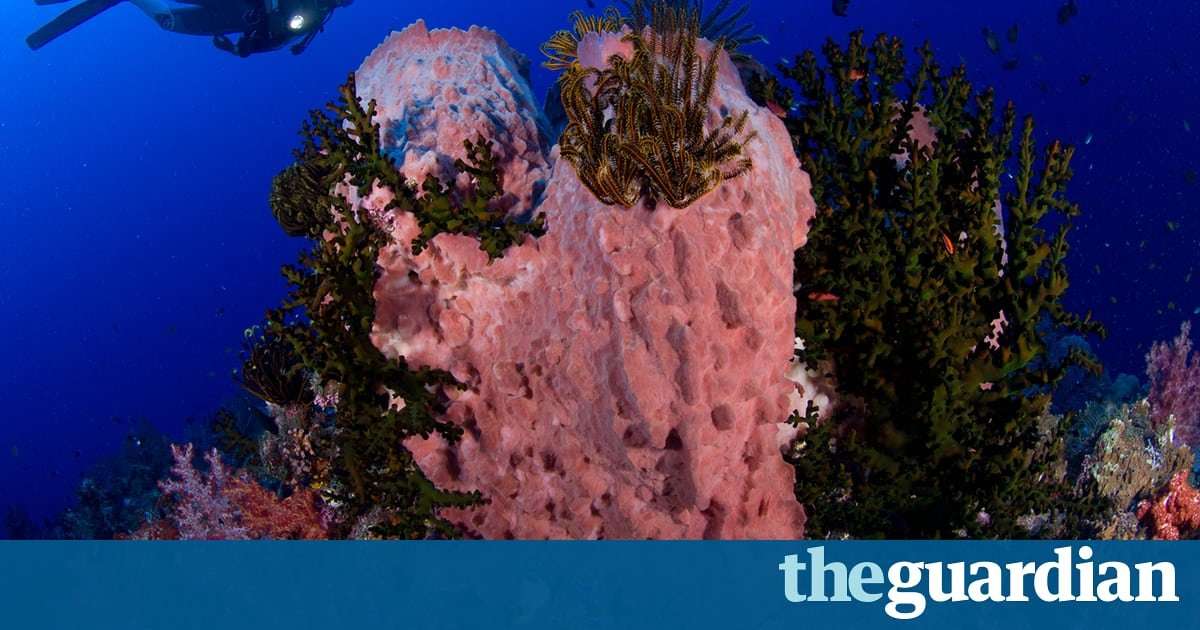Longstanding question of whether sponges or comb jellies were first to branch off the evolutionary tree from the common ancestor of all animals may be settled
A longstanding row in animal evolution has come to a head, with a team of scientists claiming they have ended the debate over which type of creature is the sister of all other animals.
Researchers have been torn for years over whether sponges or marine invertebrates known as comb jellies were the first type of creature to branch off the evolutionary tree from the common ancestor of all animals.
Now researchers say the debate is over: the sponges have won.
“We need to try to understand the sponges much better if we want to understand the nature of animals’ – and our own – deepest ancestry,” said Davide Pisani, co-author of the research and professor of phylogenomics at the University of Bristol.
Sea sponge the size of a minivan discovered in ocean depths off Hawaii Read more
The finding, say experts, is no trivial matter, as it could have drastic implications for what the last common ancestor of all animals looked like.
“Sponges are simple – humble, in a sense – creatures that live at the bottom of the sea; they are filter-feeders, they don’t do much,” said Pisani. “The comb jelly is a very different creature. They are extremely pretty and rather complicated,” he added, pointing out that comb jellies look a bit like jellyfish and can propel themselves through water, create patterns of light and have both a simple nervous system and a gut – including a mouth and anus.
Facebook Twitter Pinterest A Mnemiopsis leidyi, a species of comb jelly known as a sea walnut. Photograph: AP
“If the comb jellies are the sister of all of us, then we either are in a situation where the last common ancestor of all the animals was quite complex, [having] a nervous system, a gut and muscles and then the sponges [lost these features] or all these things we see in the comb jellies … evolved multiple times in animals,” he said, adding that the scenario also posed other puzzles such as what the ancestral creature would have preyed on.
“If the sponges are the sister group of everything else … then we can assume a much simpler scenario,” said Pisani. “Then the assumption is we evolved from a filter-feeder organism.”
With different models of evolutionary relationships applied to the same genetic data throwing up either a triumph for the sponge side of the debate or the comb jellies, the researchers of latest study turned to statistics to resolve the issue.
“With this type of approach you can evaluate the extent to which alternative models are capable of describing a dataset, so you can say ‘this model is good for this specific dataset and this model is not good’,” said Pisani.
The results, published in the journal Current Biology, were clear, he said. “Models that provide a much better description of the data invariably find the sponges at the root of the tree, for all of the datasets that have been published up to now.”
That, he adds, ties in well with the fact that the closest living relatives of all animals are filter-feeding aquatic organisms called choanoflagellates.
New to Nature No 126: Asbestopluma monticola Read more
But the findings he said, should offer us all food for thought. “I think part of why people love this debate so much is the comb jellies are beautiful and the sponges are somewhat ugly. The sponge is the underdog in a sense,” he said. “So it is quite nice to know that we have really humble beginnings, rather than this glamorous start.”
While Pisani believes proponents of the comb jellies might continue the debate, he says the wrangle is drawing to a close. “From my perspective, yes, this is the last word,” he said.
Antonis Rokas, professor of biological sciences and biomedical informatics at Vanderbilt University, and who has previously published studies supporting the idea that comb jellies are the oldest sister group to all other animals, welcomed the research. “[It] is a great step in the right direction toward resolving the debate,” he said, adding that the analyses comparing the accuracy of models are insightful.
But, he said, the new approach brings with it its own difficulties, leading him to believe the jury is still out. “With this study, the authors have significantly tipped the balance toward the sponges-sister hypothesis,” he said. “But I will eagerly await to see what are the effects of adding additional genomes from both sponge and ctenophore lineages, as well as models that do not reduce the information provided from the data, before considering the debate solved.”

ManicTeaDrinker on December 1st, 2017 at 13:10 UTC »
Literally the last paragraph of the news article:
But don't let that stop them leading the headline with "..row ends"!
dootcuzwhynot on December 1st, 2017 at 12:58 UTC »
I need a layman translation to that summary.
mvea on December 1st, 2017 at 09:46 UTC »
Journal reference:
Improved Modeling of Compositional Heterogeneity Supports Sponges as Sister to All Other Animals
Roberto Feuda11, Martin Dohrmann11, Walker Pett, Hervé Philippe, Omar Rota-Stabelli, Nicolas Lartillot, Gert Wörheide, Davide Pisani12
Current Biology 2017
Published Online: November 30, 2017
DOI: http://dx.doi.org/10.1016/j.cub.2017.11.008
Link: http://www.cell.com/current-biology/fulltext/S0960-9822(17)31453-7
Highlights
•This is the first comparison of model adequacy in non-bilaterian phylogenomics •Animal relationships depend on the ability of the models to describe the data •Sponges are the sister group of the remaining animals •Trees showing comb jellies as the sister of all the other animals are artifactual
Summary